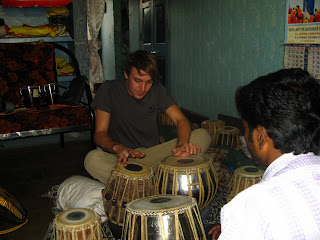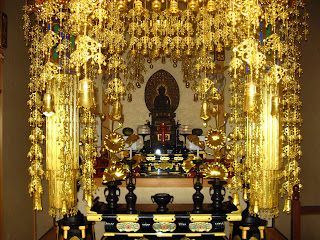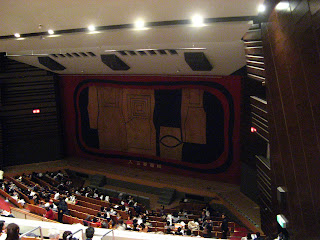December 27, 2007
Today, I had my first tabla lesson. After lunch, Anthony and his friend, Kalai, picked me up and drove me to a small house near the beach (yes, there is a huge beach in Chennai, and oddly enough, although it is the most public part of the city, it is the cleanest. Go figure). The neighborhood, mostly comprised of fishermen, is a pretty interesting, chiefly because it was completely decimated in the 2004 tsunami, but there still are tons of people residing there.
Kalai introduced me to Chandran and his son, Jacob. Chandran is 52 years old, has been playing tabla for over thirty years, and is a recording artist. Jacob, also a tabla player, is in his mid-twenties, and has played for eight years. Although Chandran was there for the whole two-plus hour lesson, Jacob was the main teacher.
(Minor clarification: the tabla is two hand drums, the left one bigger than the right one. “Tablas” is not a word; so I will always refer to it in the singular “tabla,” even though I am referring to two drums).
From having watched many tabla performances, I always have had a tremendous appreciation for level of musicianship it takes to play the instrument. The tabla is not just a hand drum that you bang away at: it is a very delicate drum that can only be played in a specific manner. The proper tones will not come out by just hitting the drum.
Indeed, like Western drums, tabla provides the rhythm for the music: nonetheless, for all intensive purposes, I might as well been trying to play a saxophone. The mechanics required to play a tabla are more akin to that of a piano, than a drum set or even bongos.
Actually that is not entirely true, because unlike the piano, with the tabla, you can only use certain fingers, certain combinations of those certain fingers, and even more complexly, certain parts of those certain fingers! (Yes, I intentionally worded that as confusingly as possible to put you all in the mental state I was in during my lesson).
What fascinated me was how each finger must be in a precise position, in order to get the proper tone out of the tabla. To clarify, if your middle finger on your right hand is touching the head, the drum will not make the right sound. Playing the tabla requires a tremendous amount of coordination between your hands and even more so among your digits: the right and left hand are never in identical positions, and the tabla must only be played with the tips of your fingers. (There is another sound made from the heal of your hand, but fingertips are used most often). I was told to pretend the right tabla was on fire, and thus to always play it staccato, never leaving my finger on the drum for more than a split second.
Jacob and I worked on the positioning of the hands and fingers, and other mechanical techniques. I did learn one basic, sixteen-bar beat, the “Teental.” Here is a little chart of the beat:
Dha Dhin Dhin Dha (called the “Sam”)
Dha Dhin Dhin Dha (called the “Tali”)
Dha Thin Thin Tha (called the “Kali”)
Tha Dhin Dhin Dha (also called the “Tali”…maybe I took that down wrong?)
This might not even be worth reading, but here is my description of that chart:
For “Dha,” you use your right index finger and left index finger at the same time. For “Dhin,” you use your right index finger and left index and middle fingers at the same time. The second “Dhin” is played the same as the “Dha.” For “Thin,” you use your right index figure and you close your entire left hand on the drum. For “Tha,” you only use your right index finger. Remember the middle finger on your right hand must never touch the drum, and the ring finger on your right hand must always touch the drum but ever so gently. Got it???
Before he first touched the tabla, Jacob, an Indian Christian, crossed himself. As I have written about before, the tabla is an intricate part of Hindu rituals and prayers. For Hindus, the tabla is not just a manifestation of Saravati, the Goddess of Music and Knowledge, but is Saravati Herself. (I do not think a Western could ever understand this concept; I know I don’t). The tabla is used in various Muslim rituals and prayers, but of course, the central tenet of Islam maintains absolute monotheism, and rejects all forms of idolatry, thus eliminating the prospect of God manifesting Himself in any material way, like in a drum for instance. I am not positive, but do not think that a Muslim would “bless” his tabla the way a Hindu would.
I found it extremely intriguing that an Indian Christian would bless himself and the drum. I would assume that this is a result of an Indian Hindu converting to Christianity. (Jacob is not a convert; he was born a Christian. Nevertheless, clearly, at some point in his family’s lineage, there was a conversion). Thus, within the scope of Hinduism, certain mannerisms, like the proper etiquette of how to handle the tabla, have been transferred to that of the Indian Christian musician. That is to say, I have never heard of an American Baptist crossing himself before playing his drums in church – but, of course, when it comes to religion and music, anything is possible.
Here is a video of Chandran playing the tabla, and another of him and Kalai performing a folk Tamil song.






















































